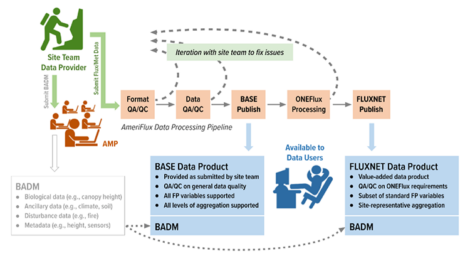AmeriFlux Network and AmeriFlux Management Project
Watching the terrestrial biosphere breathe
Project website | Overview brochure
Principal investigators: Margaret Torn and Dennis Baldocchi

Map of AmeriFlux Locations. 630 eddy covariance sites have joined the AmeriFlux Network. The purple symbols indicate the 440 studies in the Western Hemisphere with data available for download. [Courtesy Lawrence Berkeley National Laboratory]
The largest flows of carbon between land and atmosphere come from terrestrial ecosystem photosynthesis and respiration. Across the Americas, independent investigators measure these flows at more than 600 sites, using a technique called eddy covariance. Some sites are strategically clustered, for example over a gradient in rainfall, to focus on ecosystem responses to environmental variation. Other sites measure how land use and agricultural practices affect carbon, water, and energy fluxes.
By collecting, processing, and sharing the data collected by all these teams, the AmeriFlux Network provides a platform for research that spans the full spectrum of ecosystems and climates, from Amazonian rainforests to the tundra on the North Slope of Alaska. The scientific community uses these measurements to assess responses of terrestrial ecosystems to environment, land use, and events such as droughts, storms, or wildfire, as well as to quantify carbon sequestration. Knowledge gained from this network not only leads to improved understanding of important ecosystem processes and enhanced predictions in Earth system models but also advances foundational understanding of the Earth system to inform future energy and resource decisions.
The AmeriFlux Network formed in 1996 with early support by the U.S. Department of Energy (DOE), Forest Service, NASA, and National Oceanic and Atmospheric Administration. Starting with just 15 sites in 1997, AmeriFlux is now entering its 28th year with more than 600 sites. Compared to 10 years ago, the network has better coverage in South and Central America and Canada, and data available for four times as many sites (499), 80% of them under an open CC-BY-4.0 license. 60 of these have data time series 15 years or longer, and over 3600 site-years of data can be downloaded.
As a grassroots, investigator-driven network, the AmeriFlux community tailors instrumentation to suit each unique ecosystem. This “coalition of the willing” is diverse in its interests, technology uses, and collaborative approaches.

US-Nrf Tower. AmeriFlux researchers check a wetland flux tower in the Billy Frank Jr. Nisqually National Wildlife Refuge in Washington. [Courtesy Isa Woo]
The AmeriFlux Management Project (AMP)
In 2012 DOE established the AmeriFlux Management Project (AMP, ameriflux.lbl.gov) at Lawrence Berkeley National Laboratory to support the broad AmeriFlux community and the AmeriFlux sites. AMP works with AmeriFlux scientists and sites to ensure the quality and availability of the continuous, long-term ecosystem measurements necessary to understand these ecosystems and to build effective models and multisite synthesis. The rapid growth of the AmeriFlux Network presents both challenges and opportunities. AMP is scaling its technical and data services to support hundreds of sites in collecting and sharing data, and thousands of researchers in utilizing the shared data.
AMP works with the scientific community to:
- Enhance observations of ecosystem fluxes at all AmeriFlux sites, with direct operational support to a set of Core sites to ensure long-term, high-quality data.
- To ensure that data from this network of independent researchers are comparable and consistent, AMP deploys its technical team with specialized mobile flux instrumentation to visit AmeriFlux sites and has a new “site visit lite” program to evaluate data quality remotely for a larger number of sites.
- Enable scientists to study disturbances, such as wildfire or hurricanes, by loaning portable, rapid response systems for up to three years.

Eddy Covariance Method to Measure Flux. The eddy covariance method derives fluxes of carbon, water, and energy between the ecosystem (vegetation and soil) and the atmosphere. This method measures the velocity of air drafts as they move up and down and the instantaneous concentration of trace gases in those drafts. At AmeriFlux sites, these fluxes are measured directly, continuously, and over large areas, without disrupting the systems being studied. With advances in computational capability and instruments that measure wind turbulence and fluctuations of trace gases quickly and reliably, use of the eddy covariance method has expanded worldwide. [Courtesy Lawrence Berkeley National Laboratory]
- Support technical innovation and reduce data gaps.
- Provide open-access data that are consistent, standardized, and easy to use.
- Produce gap-filled and partitioned AmeriFlux-FLUXNET data product using the ONEFlux pipeline.
- Strengthen the AmeriFlux community and its early career scientists through annual community meetings, hands-on trainings, and diverse webinar offerings.
- Produce Theme Years that energize the community and increase visibility and impact of AmeriFlux research. 2022–2024 has the theme of Remote Sensing, which is connecting flux science and scientists to new datasets, NASA collaborations, and other networks. (Past themes of Methane Fluxes and Water Fluxes continue to produce community-led synthesis activities.)
- Promote safety and inclusion in Earth sciences.
- Enhance data sharing and data credit—most data are available under an open CC-BY-4.0 license, and all data receive DOIs for easy citations.
Key Science Goals
- Quantify sources and sinks for terrestrial ecosystem carbon, and how they are influenced by disturbance, land use, climate, nutrients, and pollutants.
- Understand processes associated with photosynthesis, respiration, and carbon storage in ecosystems.
- Collect observations that promote understanding and modeling of the current global carbon budget.
- Enable improved predictions of future atmospheric carbon concentrations.

Data Flows. Data are uploaded, checked for quality, and made freely and publicly available to the global scientific community. AmeriFlux works with other flux networks around the world to create standardized data products so that researchers can more easily compare across continents and improve Earth system models. [Courtesy Lawrence Berkeley National Laboratory]

